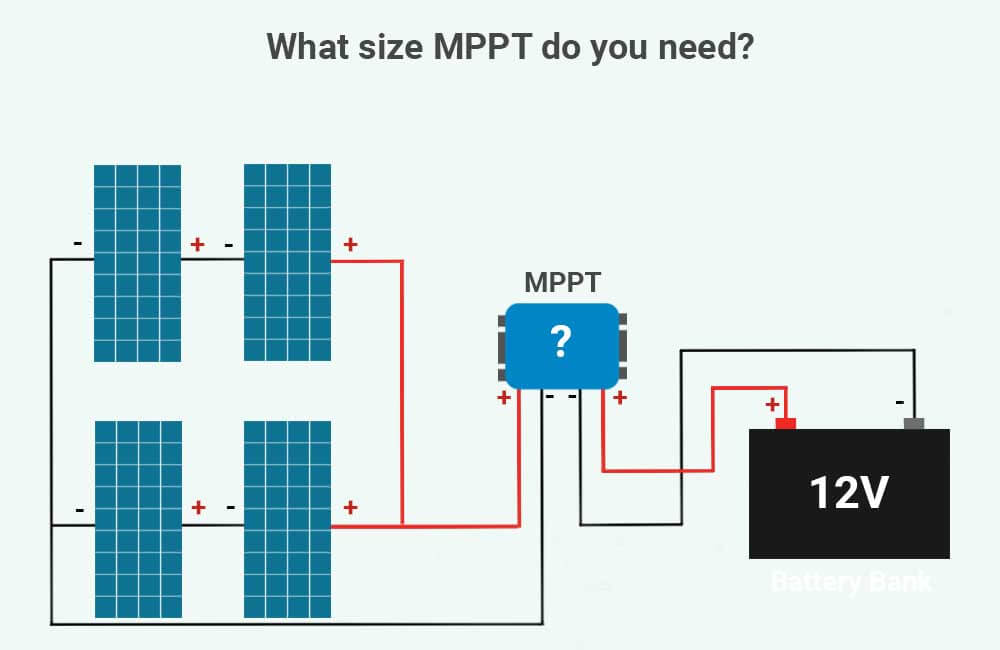
MPPT solar charge controllers are rated in amps (Output Current). To select a charge controller, you’ll need to calculate the maximum amount of current (in Amps) that the MPPT should be able to output.
This max output current value is calculated by dividing the maximum system wattage (in Watts) by the minimum charging voltage of the battery bank (in Volts).
In other words, we calculate how much current the solar charge controller needs to be able to put out by using this simple formula:
MPPT amperage rating = (Max. System Wattage) / (Min. Battery Charging Voltage)
However, MPPT charge controllers also have a Maximum Input Voltage rating, which indicates the maximum amount of voltage (in Volts) that is acceptable at the input of the MPPT.
So, when selecting your solar charge controller, you should account for both current and voltage.
But, don’t worry! I got you covered…
To make your life easier, I’ve made an MPPT size calculator that will do all the heavy lifting and give you a direct link to the charge controller best suited for your needs.
Below the MPPT calculator, I’ll give you 3 examples of different-sized solar arrays and battery banks that’ll illustrate this for you.
Also if you want a more in-depth understanding of how the calculator works, please refer to our MPPT sizing guide.
I get commissions for purchases made through links in this post.
MPPT Size Calculator
The MPPT calculator has 6 input fields that will describe your solar energy system:
1- Solar panel wattage: This is the watts rating on each of your solar panels.
2- Solar panel open-circuit voltage (Voc): You can find this value in the specification label on the back of your solar panels, or by looking up the specific model. But please make sure that you use the STC (Standard Testing Conditions) rating for this particular input.
3- Battery bank voltage (Nominal Voltage): The voltage of each battery is usually written on the casing. If you have more than one battery, the voltage of the battery bank is equal to the voltage from one string of batteries (series).
4- Lowest temperature during sunlight hours: In this field, you should enter the lowest value of temperature that you estimate your solar panels are ever going to be exposed to.
5- Number of strings: In your solar array, how many parallel strings are there?
6- Number of solar panels in each string: In each string, how many solar panels are wired in series?
MPPT Solar Charge Controller Calculator
As promised, below you’ll find a few examples that’ll clear things up for you.
- In these examples, I’ll use the 100W-12V Monocrystalline Solar Panels from Renogy. The manufacturer specifies 22.3V as an open-circuit voltage for these panels.
- For the batteries, I will use these 100 Ah 12V LiFePO4 Deep Cycle Battery from Battle Born.
- I will also assume the lowest temperature during sunlight hours these panels in the examples will ever be exposed to is estimated at -3°F.
Example 1: 200W-12V solar array with a 12V battery bank
For the first example, we have 2 100W-12Vwatts solar panels, these panels are wired in series and need to charge a 100Ah-12V Battle Born battery.
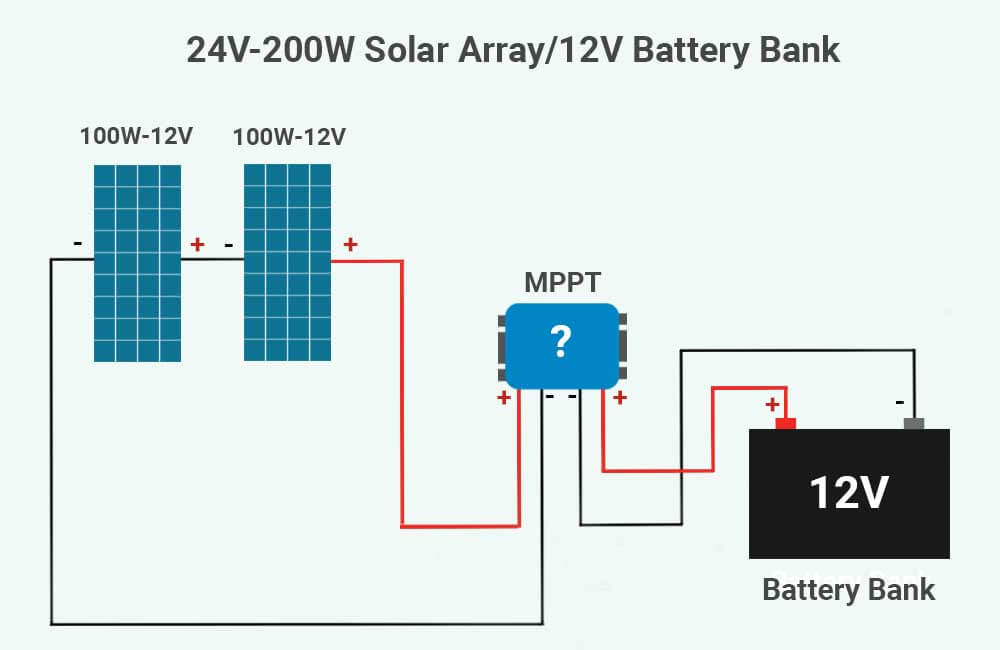
Now we need to select the right size MPPT charge controller for this system.
So what do we know so far?
- We have 2 100W-12V solar panels wired in series.
- Our battery bank’s voltage is 12V nominal.
We still need 2 pieces of information:
- The open-circuit voltage (Voc) on these panels.
- The lowest temperature these panels will be exposed to.
As mentioned above, the manufacturer specifies 22.3V as the open-circuit voltage for each of these panels.
The lowest temperature in our example is -3°F.
Now that we have all the information we need, let’s take a look at the results from the MPPT calculator.
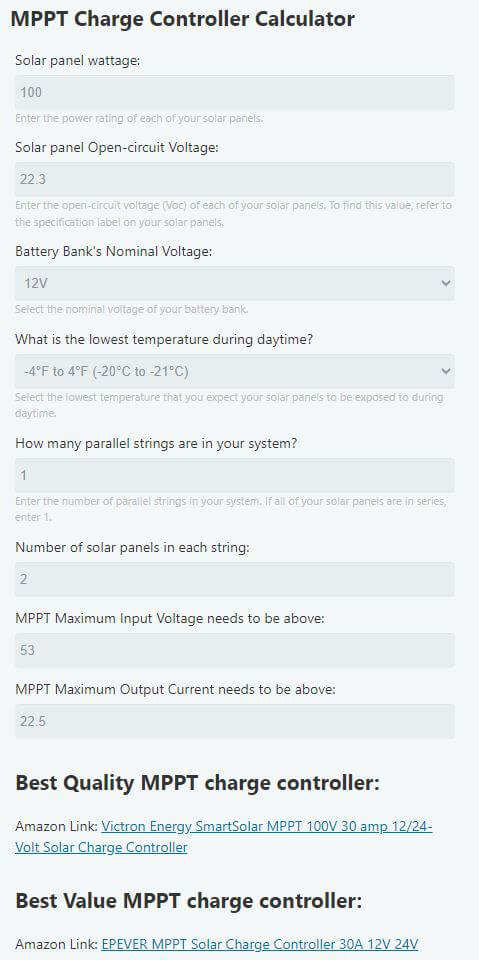
The MPPT calculator tells us that our solar charge controller needs to have a maximum voltage input of more than 53V, and needs to be able to put out 22.5 amps.
The calculator also gave us links to 2 choices for MPPT charge controllers that meet these criteria.
Example 2: 400W-24V solar array with a 12V battery bank
For the 2nd example, we have 4 100W-12V solar panels, these panels are wired in 2S2P (2 parallel strings with 2 solar panels in each string).
These panels need to charge 2 parallel wired 100Ah-12V batteries.
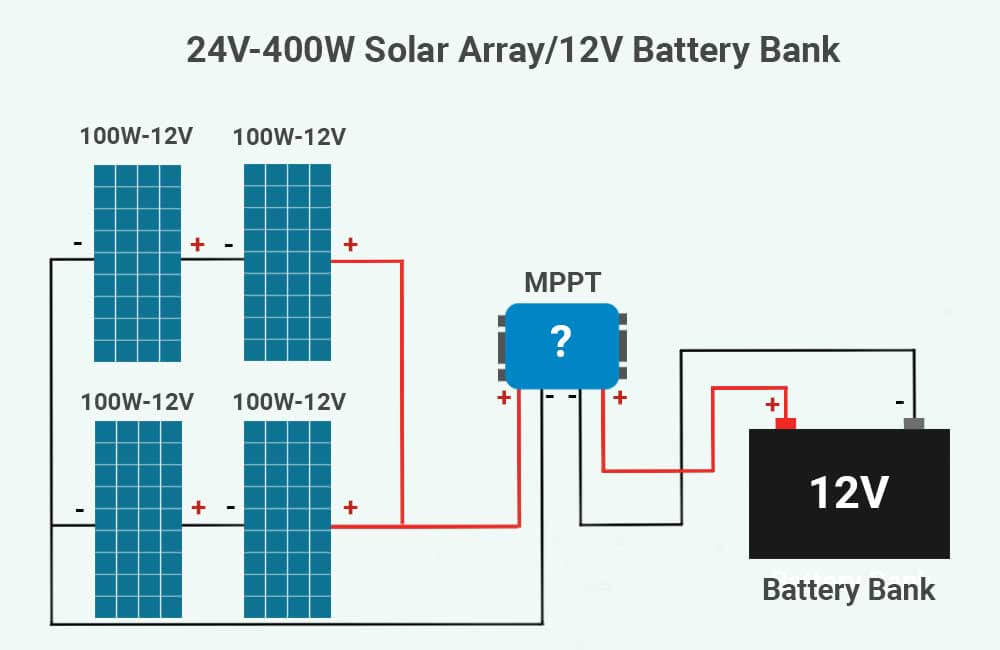
So what we know is:
- We have 2 parallel strings.
- 2 solar panels in each string.
- The power rating of our solar panels is 100W.
- The open-circuit voltage of our solar panels is 22.3V.
- The voltage of our battery bank is 12V.
- The lowest temperature is -3°F.
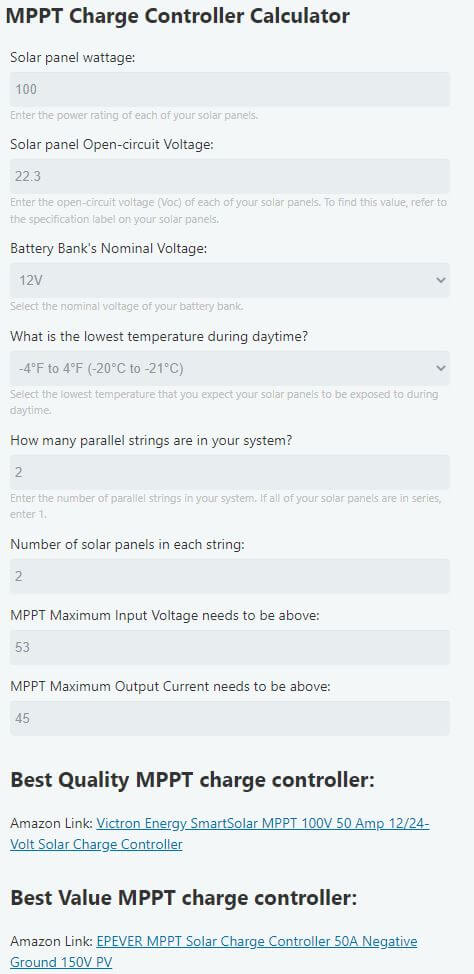
For this system, the MPPT calculator suggests a Victron 100V-50A charge controller and an EPEVER 50 amp charge controller.
Both of these charge controllers can handle the anticipated 53 Volts at their input and can put out up to 50 Amps of current.
Example 3: 200W-24V solar array with a 24V battery bank
For the third example, we have 4 100W-12V solar panels. And same as the 2nd example, these panels are wired in 2S2P.
However, the solar panels in this system need to charge 2 series wired 100Ah-12V batteries.
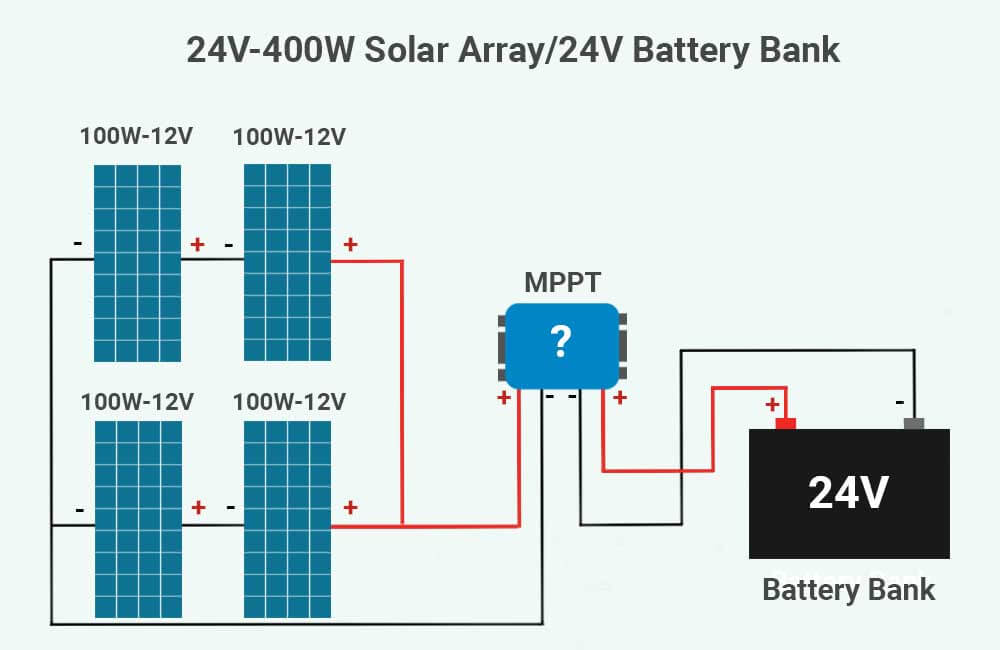
So for this example:
- We have 2 parallel strings.
- 2 solar panels in each string.
- The power rating of our solar panels is 100W.
- The open-circuit voltage of our solar panels is 22.3V.
- The voltage of our battery bank is 24V.
- The lowest temperature is -3°F.
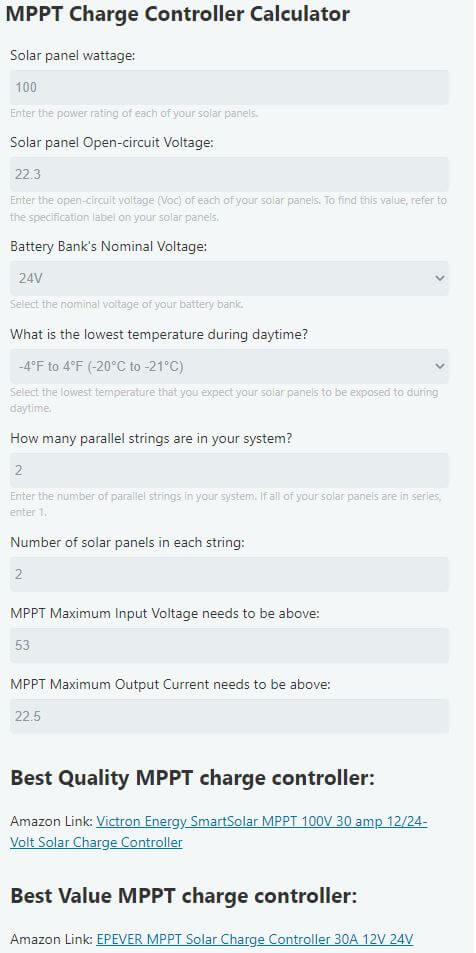
Related topics:
What size wire between solar panels and MPPT?
What size wire between the MPPT and the battery?
Solar panels in series and in parallel – What is the difference?


i recently bought a 200 amp, 12volt batter with blue tooth, 40 amp Renogy charge controller, 2-100 watt solar panels. from your examples above with 4-100 watt panels, i could add 4 more panels to my system without replacing my charge controller for a 60 amp or higher.
Am i understanding thjis correctly? thanks Steve
Hey there Steve,
Before you make any decisions, I suggest testing the number of solar panels that you intend to add in the calculator.
Thanks Younes you have done a very good job in educating readers about MPPT. However, you have stopped short of explaining the MPPT calculator which I believe will impact on practicing engineers like me. I wish more effort.
Abba
Very comprehensive, thank you! As it turns out, I am already using the Renogy 200W Kit (2 panels w/20A Rover), and now have 6 lead-acid 6V batts in 3banks. I’m having a problem keeping the charge up (52-70%), and thinking that I am not getting enough solar to replenish the batteries over a 4-5day stay. I’m not sure how to look at this, as I am trying to decide if I have too many batteries (to decrease the batts), or not enough solar panels (add panels)!?
Hey there Mike,
From what I understand, you have 6 Lead-Acid batteries each rated at 6V-100Ah, and each 2 of these are wired in series to make a 12V-100Ah battery. This means that you have a 12V-300Ah battery bank in total, making your total rated Energy Capacity 3600 Watt-hours (3.6 kWh).
On the other hand, you only have 200W of solar, which means that at most you’ll be getting 1200 Wh of energy on a daily basis. This is, of course, assuming optimal sunlight.
This means that even if you don’t discharge your batteries at all, you’ll need 3 days to take the battery from 0% to 100%.
So, to answer your question, you need more solar panels.
Hope this helped.
Hi I have 4 200w panels 800w Open Circuit Voltage (Voc): 21.6V is my Victron mppt 150 70 tr over the top and probably would not work 100%
Hey there Brian,
Have you specified the Nominal Voltage of the battery and the configuration of the solar panels (series/parallel/combination of both) to the calculator?
If you do, it should provide a couple of links to appropriate MPPTs.
Thank you very much for prviding this information. have a great day
Hi,
I want to know about the lowest temperature during daytime. Is it the lowest temperature for where I live on yearly basis?
By the way Thanks for your articles. I was looking for these informations.
Hello Tom,
Yes, I’m referring to the lowest temperature possible when the solar panels are capable of producing voltage, which is only possible in daytime hours. If you don’t have an exact data point, just put an estimate.
Glad to have helped.
To keep things simple The figures I am using are just examples.
I plan to use a 5,000 watt hybrid inverter with a MPPT charge controller and 3,000 watts of solar power.
And Im not sure if a MPPT controller is more efficient running input DC voltage at say 150 volts DC or 450 volts DC. since my AC voltage will be 120 volts AC
Hello there Wayne,
Well, I would say higher voltage means less current, so cheaper wires. But in terms of efficiency, as long as the MPPT can handle the voltage, and the output current at that voltage, I’d say it doesn’t really matter. But I still would need to look at the specs of your setup to understand what you’re trying to do.
hello ,i have 2 x 12v 200hah deepcycle batteries,3 off 380w solar panels,42 VOC on panels
panels connect in series
battery bank 12v
Please assist with correct size of controller
Hey there Gideon,
According to the calculator you would need a solar charge controller rated at an input voltage of 150V and output current of 110 Amps. I suggest you wire those batteries in series, making a 24V battery bank. This configuration will allow you to use a 150V 60A charge controller, just make sure it’s compatible with battery voltage (24V), like this controller from Victron or this one from Epever.
Hello,
I have a system withh two solar panels of 450w each (so 900w in total).
The VOC of each panel is 50.2v; current at full power: 10.77 A.
The inverter is a hybrid and includes the charge controller.
It’s specs are 3KW 24v MPPT 50A/100V VPM. The regulator charge current is 50 A.MPPT
and the charger charging current 30A.
(https://www.wccsolar.net/product-page/inversor-solar-3kw-24v-h%C3%ADbrido-regulador-mppt-50a-cargador-30a?lang=en)
There are two 12v batteries connected in series.
Would it be possible to add another 450w panel – so have three 450w panels
connected in parallel – and keep using the same hybrid inverter?
I’ve tried using the MPPT calculator but don’t seem to be able to enter 0 for
number of panels in series and am not sure about the results…
Your help would be appreciated!
Hey there Lucy,
On the calculator you should enter “1” rather than “0”. Please try that and it’ll give you your answer.
I’ve entered the specs you provided and seems that you would need a solar charge controller with an output current rating of at least 57.4 Amps to make use of 100% of your solar panels’ power production.
This means that if you do add a 3rd panel, and all 3 solar panels produce 450 Watts each, you’ll lose about 7.4 amps at 24 volts, maybe more if the temperature is colder while sunlight is at its peak.
However, realistically, your solar panel will rarely produce 450 Watts each, and even if they do, that wouldn’t last more than an hour or so, so a little bit of clipping is okay.
What I’m trying to say is, yes, you can add a 450 Watt solar panel in parallel to your array.
Hope this helped!
Thanks very much for your reply, much appreciated!
Hi Younes,
I have 2x100W solar panels with Renogy 30A MPPT with 12V Battery bank. I recently got 2 x 250W panels, according the calculations the 2x250W would require a 50A MPPT.
What would I need if I want to run 2x100W (Voc 22.3) + 2x250W (Voc 37.9) panels? Would it be best to run 2x100w on one string and 2x250w on another string?
Thx
Hey there Derek,
I would suggest you get another MPPT for the 250W solar panels, because you can’t really wire them with the 100W solar panels in the same array (even in separate strings) due to mismatched voltage and current.
Hola Good Sir,
Thank you for all this information and being a fantastic DIY solar resource for all of us newbies out here. I was hoping to get your thoughts on a charge controller sizing query if you don’t mind. I currently have a 1050 W panel array arranged in series (3- 350W panels) and am looking to get a Victron 150/35 controller. I ran a few calculations recommended on other sites for my battery bank of three 12V lead acid batteries, arranged in series, which gave me the figure of ~30 A. Is that enough of a buffer for this system or should I go for the 150/45 model as an added precaution? It’s a little more than I want to spend but if it’s necessary I shall get it.
Kindest Regards
Hey Cam,
Yes I ran the calculations and it seems a 150/35 Amp MPPT would be enough for your setup. The only reason you I would go for a 150/45 model is if you’re planning on adding more panels later.
But even with a 150/35 model, you can still add another panel if you add a battery and upgrade to a 48V battery bank. However, if you do get a 150/45 model, you’ll be able to add up to 3 more panels later if you want, as long as you upgrade to a 48V battery bank.
Good luck!
I have a mishmash of panels some 80 W, some 100 W some 120 w, all 12v.
I have them in 3 strings, parallel wired, connected to pwm controllers.
How much variation would be allowable in voltage and amperage to connect them in series to a mppt controller?
If you were to connect them in series, Voltage wouldn’t really matter. The problem is current, if you connect these solar panels in series, the string current would become equal to that of the current produced by the 80W panel.
I would recommend keeping them wired in parallel.
Younes, thanks for your calculations. I am trying to work backwards into this answer for how many panels I can connect to a controller I already own. I have the renogy rover 60amp. It has Max. PV Input Voltage: 140VDC and charge current of 60amp. I have 2 12 volt lifepo lipo batteries. I asked renogy how many of the 100w panels with 24.3 VOC and they said 6 in parrellel. This seems off to me and using your calculator it appears I should be able to connect 12 panels total, 4 in series and 3 banks of them. Am I missing something, maybe using an incorrect number?? thanks for your page. btw I’m subscribing!
Hey there Chris,
It also depend on the output voltage rating of the MPPT, if its rated at 24V for output voltage and those batteries are going to be wired in series, then yes, you can use 12 solar panels with the configuration you described, you may even be able to do 15 panels (5S3P).
But if your batteries will be wired in parallel, and the MPPT is rated at 12V output, you’ll only be able to do 50% of that.
Hi,
I’m looking to build a solar backup for home. I have a 3500 Watt 12V Pure Sine Inverter. I looking to get a 12V 100Ah lithium battery and MPPT controller. How many 100W solar panels would I need to use the inverter for 24 hours if necessary?
Hey Marshall,
It depends on how much energy (watt-hours) you use in a 24 hours period. I recommend you check out our off-grid solar calculator.
Hello Younes,
I’m trying to get solar power to my off-grid garage. It’s a very sunny area but gets down to single digits in winter on occasion.
I currently have 5 Canadian Solar panels (model CS6U-325P):
Nominal Max Power: 325W
Optimum operating voltage: 37V
Optimum operating current: 8.78A
Open circuit voltage: 45.5V
Short circuit current: 9.34A
Max system voltage: 1000V
I also have a 5000W 12/24V pure sine inverter with 120/240v output.
I tried the calculator but no links to controllers popped up, so my questions are:
Which controller would you recommend for my setup?
How many 12v batteries do i need?
Should i wire batteries in series or parallel?
Should i wire panels in series or parallel?
Thank you so much, in advance.
-Jason
Hey there Jason,
I’ve entered the data you just described into the calculator and assumed the following:
– temperature get to about 5 degrees F
– solar panels are wired in series
and the calculator determined that the voltage of the string could go up to about 260 Volts. This potential max voltage would exceed even the capabilities of something like the the victron 250V/100A MPPT.
So what I would suggest doing, is add another solar panel if possible and make a 3S2P array (6 panel array of 2 solar strings 3 panels in each string). This give you more power and allow you to use a cheaper MPPT like EPEVER 200V/100A MPPT.
Another approach you can take of course is go for one of those All in One inverters which have an integrated MPPT, these will have a much higher max input voltage usually 400-500 Volts and most of them work with 48V battery banks, which would mean you can add so much more solar and batteries if you need to.
As for how many batteries you need, it really depends on what you need to run and for how long. Keep in mind that I assumed your battery bank will be 24V, so at least 2 – 12V batteries in series.
But in general, for the amount of solar power that you have, and the particular inverter that you have which works with 24V, to make sure the solar power produced doesn’t go to waste, I would recommend at least 6 batteries, wire in a 2S3P (3 parallel strings of 2 batteries in series) configuration. This is assuming those batteries are lithium and can be fully discharged, if they were lead acid, I would go for 12 batteries in a 2S6P configuration.
Hope this helps,
feel free to comment if you have any more questions.
You calculator suggested the 100/30 mppt controller. Can you please confirm so that I’m sure I plugged in the correct numbers. Can I go with a smaller charge controller for my setup?
– 2 panels (180w each – 48 max volts) Link: https://a.co/d/bOCT1aH
– 1 Marine Deep Cycle 12v battery. Link: https://www.napaonline.com/en/p/BAT8301
As long as you’ve input the correct “lowest temperature in daylight”, 100V 30A seems about right.